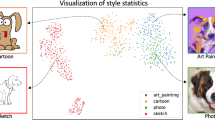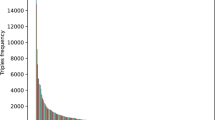Abstract
Unsupervised domain adaptation has gotten a lot of attention due to its ability to improve learning performance in a target domain based on the knowledge extracted from a source domain. Recent studies show that graph-based models can accomplish good results for domain adaptation problems. However, most of these graph-based domain adaptation approaches cannot work in an end-to-end manner, leading to the limited scalable. To address this issue, we propose a learning method named Mini-batch Dynamic Geometric Embedding (MDGE), which seeks to find the relationship between batches source and target samples to learn discriminative representations. Specifically, to build a better graph representing sample relationship, we propose a class-specific sampling strategy to pick up samples which are then used as input of MDGE. Since the samples are effectively selected, we develop a method to dynamically build a subgraph that in turn supports the relationship update and helps the network backbone to extract more discriminative features. Comprehensive experiments on real-world visual datasets demonstrate the effectiveness of the proposed MDGE algorithm.






Similar content being viewed by others
References
Wang W, Zhao F, Liao S, Shao L (2022) Attentive waveblock: complementarity-enhanced mutual networks for unsupervised domain adaptation in person re-identification and beyond. IEEE Trans Image Process 31:1532–1544
Chen J, Fang Y (2018) Deep cross-modality adaptation via semantics preserving adversarial learning for sketch-based 3d shape retrieval. In: Proceedings of the European conference on computer vision (ECCV), pp 605–620
Pan SJ, Yang Q (2009) A survey on transfer learning. IEEE Trans Knowl Data Eng 22(10):1345–1359
Zhuang F, Qi Z, Duan K, Xi D, Zhu Y, Zhu H, Xiong H, He Q (2020) A comprehensive survey on transfer learning. Proc IEEE 109(1):43–76
Tzeng E, Hoffman J, Zhang N, Saenko K, Darrell T (2014) Deep domain confusion: Maximizing for domain invariance. arXiv preprint arXiv:1412.3474
Yan Y, Wu H, Ye Y, Bi C, Lu M, Liu D, Wu Q, Ng MKP (2021) Transferable feature selection for unsupervised domain adaptation. IEEE Trans Knowl Data Eng 34:5536–5551
Wu H, Yan Y, Ng MK, Wu Q (2020) Domain-attention conditional Wasserstein distance for multi-source domain adaptation. ACM Trans Intell Syst Technol 11(4):1–19
Chen S, Wu H, Liu C (2021) Domain invariant and agnostic adaptation. Knowl-Based Syst 227:107192
Khan S, Asim M, Khan S, Musyafa A, Wu Q (2023) Unsupervised domain adaptation using fuzzy rules and stochastic hierarchical convolutional neural networks. Comput Electr Eng 105:108547
Wu H, Yan Y, Lin G, Yang M, Ng MKP, Wu Q (2020) Iterative refinement for multi-source visual domain adaptation. IEEE Trans Knowl Data Eng 34:2810–2823
Wu H, Zhu H, Yan Y, Wu J, Zhang Y, Ng MK (2021) Heterogeneous domain adaptation by information capturing and distribution matching. IEEE Trans Image Process 30:6364–6376
Wu H, Wu Q, Ng MK (2021) Knowledge preserving and distribution alignment for heterogeneous domain adaptation. ACM Trans Inform Syst 40(1):1–29
Wu Q, Wu H, Zhou X, Tan M, Xu Y, Yan Y, Hao T (2017) Online transfer learning with multiple homogeneous or heterogeneous sources. IEEE Trans Knowl Data Eng 29(7):1494–1507
Wu H, Yan Y, Ye Y, Min H, Ng MK, Wu Q (2019) Online heterogeneous transfer learning by knowledge transition. ACM Trans Intell Syst Technol 10(3):1–19
Noori Saray S, Tahmoresnezhad J (2021) Joint distinct subspace learning and unsupervised transfer classification for visual domain adaptation. SIViP 15(2):279–287
Chen M, Weinberger KQ, Blitzer J (2011) Co-training for domain adaptation. Adv Neural Inf Process Syst, pp 2456–2464
Deng Z, Zhou K, Li D, He J, Song YZ, Xiang T (2022) Dynamic instance domain adaptation. arXiv preprint arXiv:2203.05028
Duan L, Xu D, Chang SF (2012) Exploiting web images for event recognition in consumer videos: a multiple source domain adaptation approach. In: 2012 IEEE conference on computer vision and pattern recognition, pp 1338–1345 IEEE
Courty N, Flamary R, Tuia D, Rakotomamonjy A (2016) Optimal transport for domain adaptation. IEEE Trans Pattern Anal Mach Intell 39(9):1853–1865
Gretton A, Borgwardt K, Rasch M, Schölkopf B, Smola AJ (2007) A kernel method for the two-sample-problem. Adv Neural Inf Process Syst, pp 513–520
Pan SJ, Tsang IW, Kwok JT, Yang Q (2010) Domain adaptation via transfer component analysis. IEEE Trans Neural Netw 22(2):199–210
Long M, Cao Y, Cao Z, Wang J, Jordan MI (2018) Transferable representation learning with deep adaptation networks. IEEE Trans Pattern Anal Mach Intell 41:3071–3085
Long M, Zhu H, Wang J, Jordan MI (2017) Deep transfer learning with joint adaptation networks. In: Proceedings of the 34th international conference on machine learning-vol 70, pp 2208–2217 JMLR. org
Long M, Cao Y, Wang J, Jordan MI (2015) Learning transferable features with deep adaptation networks. arXiv preprint arXiv:1502.02791
Hou C-A, Tsai Y-HH, Yeh Y-R, Wang Y-CF (2016) Unsupervised domain adaptation with label and structural consistency. IEEE Trans Image Process 25(12):5552–5562
Yan H, Ding Y, Li P, Wang Q, Xu Y, Zuo W (2017) Mind the class weight bias: Weighted maximum mean discrepancy for unsupervised domain adaptation. In: Proceedings of the IEEE conference on computer vision and pattern recognition, pp 2272–2281
Fout A, Byrd J, Shariat B, Ben-Hur A (2017) Protein interface prediction using graph convolutional networks. Adv Neural Inf Process Syst 30:6533–6542
Wang X, Ye Y, Gupta A (2018) Zero-shot recognition via semantic embeddings and knowledge graphs. In: Proceedings of the IEEE conference on computer vision and pattern recognition, pp 6857–6866
Long M, Ding G, Wang J, Sun J, Guo Y, Yu PS (2013) Transfer sparse coding for robust image representation. In: Proceedings of the IEEE conference on computer vision and pattern recognition, pp 407–414
Kipf N, Welling M (2016) Semi-supervised classification with graph convolutional networks. arXiv preprint arXiv:1609.02907
Cao Z, Long M, Wang J, Jordan MI (2018) Partial transfer learning with selective adversarial networks. In: Proceedings of the IEEE conference on computer vision and pattern recognition, pp 2724–2732
Rozantsev A, Salzmann M, Fua P (2018) Beyond sharing weights for deep domain adaptation. IEEE Trans Pattern Anal Mach Intell 41(4):801–814
Goodfellow I, Pouget-Abadie J, Mirza M, Xu B, Warde-Farley D, Ozair S, Courville A, Bengio Y (2014) Generative adversarial nets. Adv Neural Inf Process Syst 27:2672–2680
Tang H, Jia K (2020) Discriminative adversarial domain adaptation. In: Proceedings of the AAAI conference on artificial intelligence vol 34, pp 5940–5947
Xu M, Zhang J, Ni B, Li T, Wang C, Tian Q, Zhang W (2020) Adversarial domain adaptation with domain mixup. In: Proceedings of the AAAI conference on artificial intelligence vol 34, pp 6502–6509
Feng Y, Chen J, Yang Z, Song X, Chang Y, He S, Xu E, Zhou Z (2021) Similarity-based meta-learning network with adversarial domain adaptation for cross-domain fault identification. Knowl-Based Syst 217:106829
Shu R, Bui HH, Narui H, Ermon S (2018) A dirt-t approach to unsupervised domain adaptation. arXiv preprint arXiv:1802.08735
Long M, Cao Z, Wang J, Jordan MI (2017) Conditional adversarial domain adaptation. arXiv preprint arXiv:1705.10667
Pei Z, Cao Z, Long M, Wang J (2018) Multi-adversarial domain adaptation. In: Thirty-Second AAAI conference on artificial intelligence
Liu H, Long M, Wang J, Jordan (2019). Transferable adversarial training: a general approach to adapting deep classifiers. In: International conference on machine learning, pp 4013–4022 PMLR
Wang X, Li L, Ye W, Long M, Wang J (2019) Transferable attention for domain adaptation. In: Proceedings of the AAAI conference on artificial intelligence, vol 33, pp 5345–5352
Lee CY, Batra T, Baig MH, Ulbricht D (2019) Sliced wasserstein discrepancy for unsupervised domain adaptation. In: Proceedings of the IEEE/CVF conference on computer vision and pattern recognition, pp 10285–10295
Saito K. Ushiku Y, Harada T, Saenko K (2017) Adversarial dropout regularization. arXiv preprint arXiv:1711.01575
Saito K, Watanabe K, Ushiku Y, Harada T (2018) Maximum classifier discrepancy for unsupervised domain adaptation. In: Proceedings of the IEEE conference on computer vision and pattern recognition, pp 3723–3732
Dai Q, Wu XM, Xiao J, Shen, X, Wang D (2022) Graph transfer learning via adversarial domain adaptation with graph convolution. IEEE Trans Knowl Data Eng 35:4908–4922
Cai H, Zheng VW, Chang KC-C (2018) A comprehensive survey of graph embedding: problems, techniques, and applications. IEEE Trans Knowl Data Eng 30(9):1616–1637
Zhou D, Bousquet O, Lal TN, Weston J, Schölkopf, B (2004) Learning with local and global consistency. Adv Neural Inf Process Syst 16:321–328
Belkin M, Niyogi P, Sindhwani V (2006) Manifold regularization: a geometric framework for learning from labeled and unlabeled examples. J Mach Learn Res 7:2399–2434
Yao L, Mao C, Luo Y (2019) Graph convolutional networks for text classification. In: Proceedings of the AAAI conference on artificial intelligence vol 33, pp 7370–7377
Gong L, Li Y, Guo J, Yu Z, Gao S (2022) Enhancing low-resource neural machine translation with syntax-graph guided self-attention. Knowl-Based Syst 246:108615
Wu H, Yan Y, Ye Y, Ng MK, Wu Q (2020) Geometric knowledge embedding for unsupervised domain adaptation. Knowl-Based Syst 191:105155
Chen J, Ma T, Xiao C (2018) Fastgcn: fast learning with graph convolutional networks via importance sampling. arXiv preprint arXiv:1801.10247
Gao H, Wang Z, Ji S (2018) Large-scale learnable graph convolutional networks. In: Proceedings of the 24th ACM SIGKDD international conference on knowledge discovery and data mining, pp 1416–1424
Hamilton W, Ying Z, Leskovec J (2017) Inductive representation learning on large graphs. Adv Neural Inf Process Syst 30:1024–1034
Saenko K, Kulis B, Fritz M, Darrell T (2010) Adapting visual category models to new domains. In: European conference on computer vision. Springer, pp 213–226
He K, Zhang X, Ren S, Sun J (2016) Deep residual learning for image recognition. In: Proceedings of the IEEE conference on computer vision and pattern recognition, pp 770–778
Gretton A, Borgwardt KM, Rasch MJ, Schölkopf B, Smola A (2012) A kernel two-sample test. J Mach Learn Res 13:723–773
Ganin Y, Lempitsky V (2014) Unsupervised domain adaptation by backpropagation. arXiv preprint arXiv:1409.7495
Long M, Zhu H, Wang J, Jordan MI (2016) Unsupervised domain adaptation with residual transfer networks. Adv Neural Inf Process Syst 29:136–144
Acknowledgements
This work was supported by National Natural Science Foundation of China (NSFC) 62272172, the Major Scientific and Technological Innovation Project of Shandong Province of China (2021ZLGX05, 2020CXGC010705), Guangdong Basic and Applied Basic Research Foundation 2023A1515012920, Tiptop Scientific and Technical Innovative Youth Talents of Guangdong Special Support Program 2019TQ05X200 and 2022 Tencent Wechat Rhino-Bird Focused Research Program (Tencent WeChat RBFR2022008), and the Major Key Project of PCL under Grant PCL2021A09.
Author information
Authors and Affiliations
Corresponding authors
Additional information
Publisher's Note
Springer Nature remains neutral with regard to jurisdictional claims in published maps and institutional affiliations.
Siraj Khan and Yuxin Guo contributed equally to this work.
Rights and permissions
Springer Nature or its licensor (e.g. a society or other partner) holds exclusive rights to this article under a publishing agreement with the author(s) or other rightsholder(s); author self-archiving of the accepted manuscript version of this article is solely governed by the terms of such publishing agreement and applicable law.
About this article
Cite this article
Khan, S., Guo, Y., Ye, Y. et al. Mini-batch Dynamic Geometric Embedding for Unsupervised Domain Adaptation. Neural Process Lett 55, 2063–2080 (2023). https://doi.org/10.1007/s11063-023-11167-7
Accepted:
Published:
Issue Date:
DOI: https://doi.org/10.1007/s11063-023-11167-7




